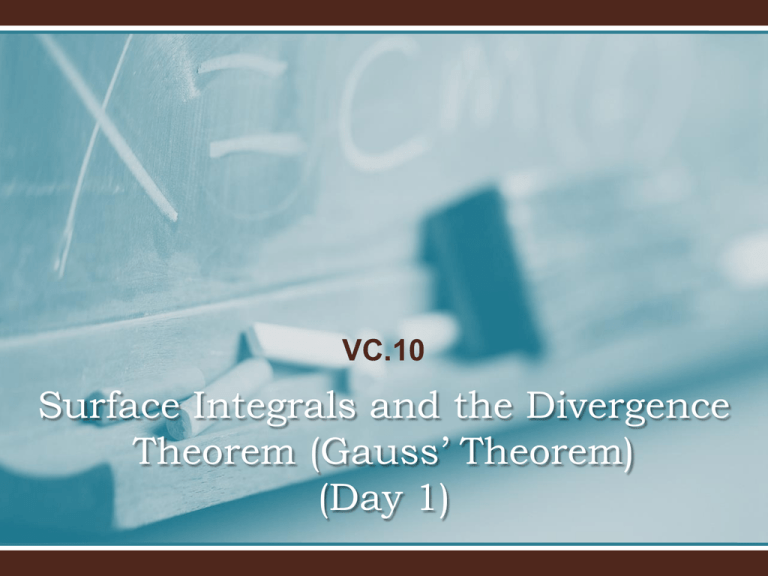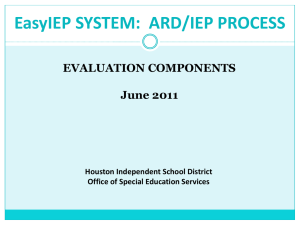VC.10 Divergence Theorem and Flow Across Surfaces
advertisement

VC.10 Surface Integrals and the Divergence Theorem (Gauss’ Theorem) (Day 1) VC.06: Measuring the Flow of a Vector Field ACROSS a Closed Curve Let C be a closed curve with a counterclockwise parameterization. Then the net flow of the vector field ACROSS the closed curve is measured by: Ñ Fie ld( x , y ) o u te ru n itn o rm al d s C b Fie ld( x( t ), y( t )) ( y '( t ), x '( t ))d t a Ñ C n( x , y )d x m ( x , y )d y Let region R be the interior of C. If the vector field has no singularities in R, then we can use Gauss-Green: m n dx dy x y R d iv Fie ld d x R dy Le t d iv Fie ld( x , y ) m x n y . VC.06: The Flow of A Vector Field ACROSS a Closed Curve: Let C be a closed curve parameterized counterclockwise. Let Field(x,y) be a vector field with no singularities on the interior region R of C. Then: Ñ Fie ld( x , y ) o u te ru n itn o rm al d s C d iv Fie ld d x dy R This measures the net flow of the vector field ACROSS the closed curve. W e d e fin e th e d iv e rg e n ce o f th e v e cto r fi e ld as: d iv Fie ld( x , y ) m x n y D[m[ x , y ], x ] D[n[ x , y ], y ] VC.06: Measuring the Flow of a Vector Field ALONG a Closed Curve Let C be a closed curve with a counterclockwise parameterization. Then the net flow of the vector field ALONG the closed curve is measured by: Ñ Fie ld( x , y ) u n ittan d s C b Fie ld( x( t ), y( t )) ( x '( t ), y '( t ))d t a Ñ C m ( x , y )d x n( x , y )d y Let region R be the interior of C. If the vector field has no singularities in R, then we can use Gauss-Green: n m dx dy x y R ro tFie ld d x R dy Le t ro tFie ld( x , y ) n x m y . VC.06: The Flow of A Vector Field ALONG a Closed Curve: Let C be a closed curve parameterized counterclockwise. Let Field(x,y) be a vector field with no singularities on the interior region R of C. Then: Ñ Fie ld( x , y ) u n ittan d s C ro tFie ld d x dy R This measures the net flow of the vector field ALONG the closed curve. W e d efin e th e ro tatio n o f th e vecto r field as: ro tField( x , y ) n x m y D[n[ x , y ], x ] D[m[ x , y ], y ] VC.10: The Flow of A Vector Field ACROSS a Closed Surface: Constructing a three-dimensional analog of using the Gauss-Green Theorem to compute the flow of a vector field across a closed curve is not difficult. This is because the notion of divergence extends to three dimensions pretty naturally. We will save the three-dimensional analog of flow ALONG for next chapter… VC.10: The Flow of A Vector Field ACROSS a Closed Surface: Let R be a solid in three dimensions with boundary surface (skin) C with no singularities on the interior region R of C. Then the net flow of the vector field Field(x,y,z) ACROSS the closed surface is measured by: Ò Fie ld( x , y , z ) o u te rn o rm al d A C d iv Fie ld d x dy dz R L e t Fie ld( x , y , z ) m ( x , y , z ), n( x , y , z ), p( x , y , z ) . W e d e fin e th e d iv e rg e n ce o f th e v e cto r fi e ld as: d iv Fie ld( x , y , z ) m x n y p z D[m[ x , y , z ], x ] D[n[ x , y , z ], y ] D[p[ x , y , z ], z ] More Traditional Notation: The Divergence Theorem (Gauss’ Theorem) Let V be a solid in three dimensions with boundary surface (skin) S with no singularities on the interior region V of S. Then the net flow of the vector field F(x,y,z) ACROSS the closed surface is measured by: Ò F n d S S F d V V L e t F( x , y , z ) m ( x , y , z ) n( x , y , z ) p( x , y , z ). Let , , b e k n o w n as " d e l" , o r th e d iffe re n t ial o p e rato r. x y z N o te d iv Fie ld( x , y , z ) F m x Fin ally , le t n = o u te ru n itn o rm al. n y p z . Example 1: Avoiding Computation Altogether Le t Fie ld( x , y ) 7 x 2 , y 6 an d le t C b e a clo s e d cu rv e g iv e n b y 2 C (t) ( x( t ), y( t )) sin ( t ), co s( t ) sin ( t ) fo r t 3 . 4 4 Is th e flo w o f th e v e cto r fie ld acro ss t h e cu rv e fro m in sid e to o u tsid e o r o u tsid e to in sid e ? d iv Fie ld( x , y ) Ñ C n( x , y )d x m ( x , y )d y m x n y 71 8 d iv Fie ld( x , y ) d x R dy 8 d x dy R Sin ce d ivField (x,y) is A LW A YS p ositive f or all (x,y) an d th ere are n o sin g u larities for an y (x,y), th is in teg ral is p ositive for an y closed cu rve. Th at is, for A N Y closed cu rve, th e n et f low of th e vector field across th e cu rve is from in sid e to ou tsid e. Example 2: Avoiding Computation Altogether L e t Fie ld( x , y , z ) x y 2 3 co s(z ) , y x z , 3 z 8 x 3e y . L e t C b e th e a b o u n d in g su rface o f a so lid re g io n . Is th e flo w o f th e v e cto r fie ld acro ss t h e cu rv e fro m in sid e to o u tsid e o r o u tsid e to in s id e ? d iv Fie ld( x , y , z ) m x n y p z Ò Fie ld( x , y , z ) o u te rn o rm al d A C 2 2 1 3y 3 3y 4 d iv Fie ld d x dy dz R Sin ce d ivField (x,y,z) is A LW A Y S n eg ative at all (x,y,z) (sin ks) an d th ere are n o sin g u larities, th is in teg ral is n eg ative for an y closed su rface. Th at is, for A N Y closed su rface, th e n et flow of th e vector field across th e su rface is from ou tsid e to in sid e. Example 3: Avoiding Computation Altogether 5 3 L e t Fie ld( x , y , z ) sin (y ) z , z x co s( x ), sin (5 x y ) 3 x e xy sin ( x ) . L e t C b e th e b o u n d in g su rface o f a so lid re g io n . Is th e flo w o f th e v e cto r fie ld acro ss t h e cu rv e fro m in sid e to o u tsid e o r o u tsid e to i n sid e ? d iv Fie ld( x , y , z ) m x n y p Ò Fie ld( x , y , z ) o u te rn o rm al d A C z 0 d iv Fie ld d x dy dz R Sin ce d ivField (x,y,z) is A LW A Y S 0 for all (x,y,z) an d th ere are n o sin g u larities for an y (x,y,z), th is in te g ral is 0 for an y closed su rface. Th at is, for A N Y closed su rface, th e n et flow of th e vector field across th e su rface is 0. C Example 4: Find the Net Flow of a Vector Field ACROSS a Closed Curve L e t Fie ld( x , y ) x 2 2 2 xy , y x a n d le t C b e th e r e c ta n g le b o u n d e d b y x 2 , x 5 , y 1 , a n d y 4 . M e a su re th e flo w o f th e v e c to r fie ld a c ro ss th e c u rv e . d iv Fie ld( x , y ) m x n( x , y )d x m ( x , y )d y n 2x 4 y y d iv Fie ld( x , y ) d x dy R 4 5 2x 4 y dx dy 1 2 105 N eg ative. Th e net flow of th e vector fie ld across our closed curve is from outsid e to insid e. Example 5: Find the Net Flow of a Vector Field ACROSS a Closed Surface 2 L e t Fie ld( x , y , z ) 2 x y , y , 5 z 4 x z a n d le t C b e th e re c ta n g u la r p rism b o u n d e d b y 1 x 4 , 2 y 3 , a n d 0 z 5 . M e a su re th e flo w o f th e v e c to r fie ld a c ro ss th e c lo se d su rfa c e . d iv Fie ld( x , y ) m x n y p z 5 4x Ò Fie ld( x , y , z ) o u te rn o rm al d A C d iv Fie ld( x , y , z ) d x R 5 3 dy dz 4 5 4 x dx dy dz 0 2 1 1375 Positive. T h e n et flow of th e vector fie ld across ou r closed su rface is from in sid e to ou tsid e. Summary: The Divergence Locates Sources and Sinks Let R be a solid in three dimensions with boundary surface (skin) C with no singularities on the interior region R of C. Then: If d iv Fie ld (x,y,z)> 0 fo r all p o in ts in C , th e n all th e se p o in ts are so u rce s an d th e n e t flo w o f th e v e cto r fie ld acro ss C is fro m in sid e to o u tsid e . If d iv Fie ld (x,y,z)< 0 fo r all p o in ts in C , th e n all o f th e se p o in ts are sin k s an d th e n e t flo w o f th e v e cto r fie ld acro ss C is fro m o u tsid e to in sid e . If d ivField( x , y , z ) 0 for all p oin ts in C, th en th e n et flow of th e vector field across C is 0. The Flow of a Vector Field Across an Open Surface The Divergence Theorem is great for a closed surface, but it is not useful at all when your surface does not fully enclose a solid region. In this situation, we will need to compute a surface integral. For a parameterized surface, this is pretty straightforward: Fi e ld( x , y , z ) o u te rn o rm al d A C t2 t1 s2 s1 Fie ld( x( s , t ), y( s , t ), z( s , t )) n o rm al( s , t ) d s d t W h at is th e n o rm al ve cto r?? Normal Vectors: Curves Versus Surfaces 2-D im e n sio n s: 3 -D im e n sio n s: Fie ld( x , y ) o u te ru n itn o rm a l d s Fi e ld( x , y , z ) o u te rn o rm al d A C b Fie ld( x ( t ), y ( t )) o u te rn o rm a l d t C t2 t1 s2 s1 Fie ld( x( s , t ), y( s , t ), z( s , t )) n o rm al( s , t ) d s d t a b Fie ld( x ( t ), y ( t )) ( y '( t ), x '( t ))d t a In 2 d im en sion s, ou tern orm al ( y '( t), x '( t)). Th is is m ore su b tle in 3 d im en sion s... Normal Vectors: Curves Versus Surfaces t2 Fi e ld( x , y , z ) o u te rn o rm al d A Fo r a cu rv e C p aram e te rize d b y x( s , t ), y( s , t ), z( s , t ) , yo u C s2 t1 s1 Fie ld( x( s , t ), y( s , t ), z( s , t )) n o rm al( s , t ) d s d t can fin d tw o lin e arly- in d e p e n d e n t tan g e n t v e cto rs to th e cu rv e u sin g p artial d e riv ativ e s : x y z x y z , , , , an d s s s t t t U se th ese tw o vectors tan g en t to th e cu rve to g en erate you r n orm al vector: x y z x y z n o rm al( s , t ) , , , , s s s t t t x y z , , s s s x y z , , t t t Example 6: Using a Substitute Surface When the Divergence is 0 Le t Fie ld( x , y , z ) z y , z x , x 2 . Le t C b e th e b o u n d in g su rface o f th e so lid re g io n p ictu re d b e lo w , w h e re C is th e u n io n o f th e p o in ty cap , C 1 , an d th e e llip tical b ase C 2 . Fin d th e n e t flo w o f th e v e cto r fie ld a cro ss C 1 . Fo r 0 t 2 an d 0 s C1 : x 1 ( s , t ), y 1 ( s , t ), z 1 ( s , t ) 2 : C1 co s( s )(1 sin(8 s )) 2 sin ( s ) co s( t ), sin( s ) sin ( t ), s 4 2 C 2 : x 2 ( s , t ), y 2 ( s , t ), z 2 ( s , t ) 2 sin ( s ) cos( t ), sin( s ) sin ( t ), 0 C2 Example 6: Using a Substitute Surface When the Divergence is 0 Le t Fie ld( x , y , z ) z y , z x , x 2 . Le t C b e th e b o u n d in g su rface o f th e so lid re g io n , th e u n io n o f th e cap , C 1 , an d th e e llip tic al b ase C 2 . Fin d th e n e t flo w o f th e v e cto r fie ld acr o ss C 1 . d iv Fie ld( x , y , z ) m x Ò Fie ld( x , y , z ) o u te rn o rm al d A C n y p z 0 d iv Fie ld d x dy dz 0 R S o th e n e t flo w o f th e v e cto r fie ld acro ss th e clo se d su rface C is 0 . H o w e v e r, th is calcu latio n d o e s N O T im p ly th at th e n e t f lo w o f th e v e cto r fie ld acro ss C 1 o r C 2 is 0 . Example 6: Using a Substitute Surface When the Divergence is 0 Le t Fie ld( x , y , z ) z y , z x , x 2 . Le t C b e th e b o u n d in g su rface o f th e so lid re g io n , th e u n io n o f th e cap , C 1 , an d th e e llip tic al b ase C 2 . Fin d th e n e t flo w o f th e v e cto r fie ld acr o ss C 1 . 0 d iv Fie ld d x dy dz R Ò Fie ld( x , y , z ) o u te rn o rm al d A C Fie ld( x , y , z ) o u te rn o rm al d A Fie ld( x , y , z ) o u t e rn o rm al d A C2 So Fie ld( x , y , z ) o u te rn o rm al d A C1 C1 Fie ld( x , y , z ) o u te rn o rm al d A . C2 S in ce C 2 is e asie r to w o rk w ith , w e 'll u se th is su b stitu te su rface in ste ad ! Fie ld( x , y , z ) o u te rn o rm al d A Example 3: Using a Substitute Surface Fie ld( x( s , t ), y( s , t ), z( s , t )) n o rm al( s , t ) d s d t C2 2 0 /2 0 C 2 : x 2 ( s , t ), y 2 ( s , t ), z 2 ( s , t ) 2 sin ( s ) co s( t ), sin( s ) sin ( t ), 0 x 2 y 2 z 2 x 2 y 2 z 2 n o rm al( s , t ) , , , , s s s t t t i j k x 2 y 2 z 2 s x 2 s y 2 s z 2 t t t T h e se n o rm als p o in t in j k th e co rre ct d ire ctio n 2 co s( s ) co s( t ) co s( s ) sin ( t ) 0 b e cau se fro m 0 s 2 sin ( s ) sin ( t ) sin ( s ) co s( t ) 0 i 2 ( 0 , 0 , 2 sin ( s ) co s( s )) 2 0 i 0 j ( 2 sin ( s ) c o s( s ) c o s ( t ) 2 sin ( s ) c o s( s ) sin ( t ))k ( 0 , 0 , 2 sin ( s ) c o s( s )) p o in ts u p o u t o f th e e llip tical b ase . 2 , Example 6: Using a Substitute Surface When the Divergence is 0 Fie ld( x , y , z ) z y,z x,x 2 C 2 : x 2 ( s , t ), y 2 ( s , t ), z 2 ( s , t ) 2 sin ( s ) co s( t ), sin( s ) sin ( t ), 0 Fie ld( x , y , z ) o u te rn o rm al d A C2 2 0 /2 0 2 Fie ld( x ( s , t ), y( s , t ), z( s , t )) n o rm al( s , t ) d s d t /2 sin( s )sin( t ), 2co s( t )sin( s ), 4 co s 0 0 2 /2 0 0 3 2 2 ( t )sin ( s ) ( 0 , 0 , 2 sin ( s ) co s( s )) d s d t 2 8 sin ( s ) c o s ( t ) c o s ( s ) d s d t 2 T h e n e t flo w o f th e v e cto r fie ld acro ss C 1 is w ith th e d ire ctio n o f th e n o rm al v e cto rs (d o w n to u p ). Summary: Using a Substitute Surface When the Divergence is 0 L e t C b e th e b o u n d in g su rfa c e o f a so lid re g io n su c h th a t C C 1 U C 2 fo r tw o o p e n su rfa c e s C 1 a n d C 2 . L e t Fie ld (x , y ,z ) b e a v e c to r fie ld w ith n o sin g u la ritie s c o n ta in e d w ith in C su c h th a t d iv Fie ld( x , y , z ) 0 a w a y fro m sin g u la ritie s. T h e n : Fie ld( x , y , z ) o u te rn o rm al d A C1 Fie ld( x , y , z ) o u t e rn o rm al d A C2 T h is allo w s u s to su b stitu te C 1 fo r C 2 o r v ice -v e rsa w h e n co m p u tin g a su rface in te g ral. T rad e a cr azy su rface fo r a sim p le r o n e ! N o te : Ju st b e cau se Fie ld( x , y , z ) o u te rn o rm a l d A C 0 , th at says n o th in g ab o u t C 1 o r C 2 . VC.06: Flow Across When divField(x,y)=0 Le t d iv Fie ld( x , y ) m x n y 0 . H e re are so m e co n clu si o n s ab o u t th e n e t flo w o f th e v e cto r fie ld acro ss v ario u s clo se d cu rv e s: If C d o e sn 't co n tain an y sin g u laritie s, th e n Ñ n( x , y )d x m ( x , y )d y 0 . C If C co n tain s a sin g u larity, th e n Ñ n( x , y )d x m ( x , y )d y C Ñ n( x , y )d x m ( x , y )d y C1 fo r an y su b stitu te cu rv e C 1 co n tain in g th e sam e sin g u larity ( an d n o n e w e xtras). If C co n tain s n sin g u laritie s, th e n Ñ n( x , y )d x C m ( x , y )d y Ñ n( x , y )d x C1 m ( x , y )d y ... Ñ n( x , y )d x Cn fo r little circle s , C 1 , ..., C n , e n cap su latin g e ach o f th e se sin g u laritie s. m ( x , y )d y VC.10: Flow Across When divField(x,y,z)=0 Let d ivField( x , y , z ) m x n y p z 0. H ere are so m e co n clu sio n s ab o u t th e n et flo w o f th e vecto r field ac ro ss vario u s clo sed su rfaces: If C d o e sn 't co n tain an y sin g u laritie s, th e n Ò Fie ld( x , y , z ) o u te rn o rm al d A 0. C If C co n tain s a sin g u larity, th e n Ò Fie ld( x , y , z ) o u te rn o rm al d A C Ò Fie ld( x , y , z ) o u t e rn o rm al d A C1 fo r an y su b stitu te su rface C 1 co n tain in g th e sam e sin g u larity ( an d n o e x tras). If C co n tain s n sin g u laritie s, th e n Ò Fie ld( x , y , z ) o u te rn o rm al d A C Ò Fie ld( x , y , z ) o u te rn o rm al d A C1 ... Ò Fie ld( x , y , z ) o u te rn o rm al d A Cn fo r little sp h e re s , C 1 , ..., C n , e n cap su latin g e ach o f th e se sin g u laritie s . Example 7: Using a Substitute Surface With Singularities (Details in Mathematica Notebook) y x z Le t Fie ld( x , y , z ) , , ( x 4 y 4 z 4 )3 / 4 ( x 4 y 4 z 4 )3 / 4 ( x 4 y 4 z 4 )3 / 4 an d le t C b e th e b o u n d ary to th e re g io n p ictu re d at th e rig h t. Fin d th e n e t flo w o f th e v e cto r fie ld acro ss C . d ivField( x , y ) m x n y p z 0, b u t w e h ave a sin g u larity at (0,0,0). R ep lace th e su rface w ith a sm all sp h ere cen tered at (0,0,0): Ò Fie ld( x , y , z ) o u te rn o rm al d A C 2 0 0 Fie ld( x ( s , t ), y( s , t ), z( s , t )) n o rm al( s , t ) d s d t Example 7: Using a Substitute Surface With Singularities (Details in Mathematica Notebook) Find outernorm al(s, t) : Verify they truly are O UTERnorm als: Example 7: Using a Substitute Surface With Singularities (Details in Mathematica Notebook) y x z Le t Fie ld( x , y , z ) , , ( x 4 y 4 z 4 )3 / 4 ( x 4 y 4 z 4 )3 / 4 ( x 4 y 4 z 4 )3 / 4 an d le t C b e th e b o u n d ary to th e re g io n p ictu re d at th e rig h t. Fin d th e n e t flo w o f th e v e cto r fie ld acro ss C . 2 0 0 Fie ld( x ( s , t ), y ( s , t ), z( s , t )) n o rm a l( s , t ) d s d t 1 9 .4 4 6 So th e flow of th e vector field across t h e w avy su rface (an d th e sp h ere) is in sid e to ou tsid e. For Monday… • Surface area of curved surfaces • Surface area of figures plotted on a curved surface • Surface integrals









